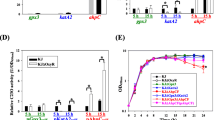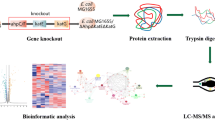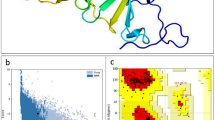Abstract
Two-dimensional gel electrophoresis was conducted to investigate the effect of H2O2 on whole protein expression in Acinetobacter oleivorans DR1. Functional classification of 13 upregulated proteins using MALDI-TOF mass spectrometry showed relationships with oxidative stress, energy production and conversion, nucleotide and amino acid metabolism, membrane-related, ion transport, and chaperone-related functions. Alignment of OxyR-binding regions from Pseudomonas aeruginosa and Escherichia coli with promoters of identified proteins revealed that only ahpC, ahpF, and trxB (thioredoxin-disulfide reductase) genes, along with a newly found oprC (putative outer membrane receptor protein) gene, have OxyR-binding sites. The oxyR and ahpC mutants were more sensitive to H2O2 and showed growth defects in both nutritional and n-hexadecane-amended media. Four catalases present in the genome of A. oleivorans DR1 were not detected, which led us to confirm the expression and activity of those catalases in the presence of H2O2. The expression patterns of the four catalase genes differed at different concentrations of H2O2. Interestingly, the promoters of both known OxyR-controlled katG gene (AOLE_17390) and putative small catalase gene (AOLE_09800) have OxyR-binding sites. Gel-shift assay confirmed OxyR binding to the promoter regions of newly identified OxyR-controlled genes encoding OprC and a putative catalase. Hierarchical expression and OxyR-binding of several OxyR-controlled genes suggested that concentration is an important factor in inducing the set of genes under H2O2 stress.





Similar content being viewed by others
References
Adler C, Corbalan NS, Peralta DR, Pomares MF, de Cristóbal RE, Vincent PA (2014) The alternative role of enterobactin as an oxidative stress protector allows Escherichia coli colony development. PLoS One 9:e84734
Alcantara RB, Read RD, Valderas MW, Brown TD, Roop RM II (2004) Intact purine biosynthesis pathways are required for wild-type virulence of Brucella abortus 2308 in the BALB/c mouse model. Infect Immun 72:4911–4917
Aslund F, Zheng M, Beckwith J, Storz G (1999) Regulation of the OxyR transcription factor by hydrogen peroxide and the cellular thiol-disulfide status. Proc Natl Acad Sci U S A 96:6161–6165
Bergogne-Bérézin E, Towner KJ (1996) Acinetobacter spp. as nosocomial pathogens: microbiological, clinical, and epidemiological features. Clin Microbiol Rev 9:148–165
Cabiscol E, Tamarit J, Ros J (2000) Oxidative stress in bacteria and protein damage by reactive oxygen species. Int Microbiol 3:3–8
Chauvatcharin N, Atichartpongkul S, Utamapongchai S, Whangsuk W, Vattanaviboon P, Mongkolsuk S (2005) Genetic and physiological analysis of the major OxyR-regulated katA from Xanthomonas campestris pv. phaseoli. Microbiology 151:597–605
Denef VJ, Patrauchan MA, Florizone C, Park J, Tsoi TV, Verstraete W, Tiedje JM, Eltis LD (2005) Growth substrate- and phase-specific expression of biphenyl, benzoate, and C1 metabolic pathways in Burkholderia xenovorans LB400. J Bacteriol 187:7996–8005
Denef VJ, Klappenbach JA, Patrauchan MA, Florizone C, Rodrigues JL, Tsoi TV, Verstraete W, Eltis LD, Tiedje JM (2006) Genetic and genomic insights into the role of benzoate-catabolic pathway redundancy in Burkholderia xenovorans LB400. Appl Environ Microbiol 72:585–595
Dubbs JM, Mongkolsuk S (2012) Peroxide-sensing transcriptional regulators in bacteria. J Bacteriol 194:5495–5503
Farr SB, Kogoma T (1991) Oxidative stress responses in Escherichia coli and Salmonella typhimurium. Microbiol Rev 55:561–585
Fu X, Wang W, Hao J, Zhu X, Sun M (2014) Purification and characterization of catalase from marine bacterium Acinetobacter sp. YS0810. Biomed Res Int 2014:409626
Fukumori F, Kishii M (2001) Molecular cloning and transcriptional analysis of the alkyl hydroperoxide reductase genes from Pseudomonas putida KT2442. J Gen Appl Microbiol 47:269–277
Habe H, Kobuna A, Hosoda A, Kosaka T, Endoh T, Tamura H, Yamane H, Nojiri H, Omori T, Watanabe K (2009) Identification of the electron transfer flavoprotein as an upregulated enzyme in the benzoate utilization of Desulfotignum balticum. Biosci Biotechnol Biochem 73:1647–1652
Hickman JW, Barber RD, Skaar EP, Donohue TJ (2002) Link between the membrane-bound pyridine nucleotide transhydrogenase and glutathione-dependent processes in Rhodobacter sphaeroides. J Bacteriol 184:400–409
Hishinuma S, Yuki M, Fujimura M, Fukumori F (2006) OxyR regulated the expression of two major catalases, KatA and KatB, along with peroxiredoxin, AhpC in Pseudomonas putida. Environ Microbiol 8:2115–2124
Hishinuma S, Ohtsu I, Fujimura M, Fukumori F (2008) OxyR is involved in the expression of thioredoxin reductase TrxB in Pseudomonas putida. FEMS Microbiol Lett 289:138–145
Hong H, Ko HJ, Choi IG, Park W (2014) Previously undescribed plasmids recovered from activated sludge confer tetracycline resistance and phenotypic changes to Acinetobacter oleivorans DR1. Microb Ecol 67:369–379
Imlay JA (2003) Pathways of oxidative damage. Annu Rev Microbiol 57:395–418
Imlay JA (2013) The molecular mechanisms and physiological consequences of oxidative stress: lessons from a model bacterium. Nat Rev Microbiol 11:443–454
Ivanova A, Miller C, Glinsky G, Eisenstark A (1994) Role of rpoS (katF) in oxyR-independent regulation of hydroperoxidase I in Escherichia coli. Mol Microbiol 12:571–578
Jamet A, Kiss E, Batut J, Puppo A, Hérouart D (2005) The katA catalase gene is regulated by OxyR in both free-living and symbiotic Sinorhizobium meliloti. J Bacteriol 187:376–381
Jung J, Park W (2015) Acinetobacter species as model microorganisms in environmental microbiology: current state and perspectives. Appl Microbiol Biotechnol 99:2533–2548
Jung J, Baek JH, Park W (2010) Complete genome sequence of the diesel-degrading Acinetobacter sp. strain DR1. J Bacteriol 192:4794–4795
Jung J, Madsen EL, Jeon CO, Park W (2011) Comparative genomic analysis of Acinetobacter oleivorans DR1 to determine strain-specific genomic regions and gentisate biodegradation. Appl Environ Microbiol 77:7418–7424
Jung J, Jang IA, Ahn S, Shin B, Kim J, Park C, Jee SC, Sung JS, Park W (2015) Molecular mechanisms of enhanced bacterial growth on hexadecane with red clay. Microb Ecol. doi:10.1007/s00248-015-0624-5
Kalogeraki VS, Winans SC (1997) Suicide plasmids containing promoterless reporter genes can simultaneously disrupt and create fusions to target genes of diverse bacteria. Gene 188:69–75
Kang YS, Park W (2010) Contribution of quorum-sensing system to hexadecane degradation and biofilm formation in Acinetobacter sp. strain DR1. J Appl Microbiol 109:1650–1659
Kim J, Park W (2013) Identification and characterization of genes regulated by AqsR, a LuxR-type regulator in Acinetobacter oleivorans DR1. Appl Microbiol Biotechnol 97:6967–6978
Kim J, Park W (2014) Oxidative stress response in Pseudomonas putida. Appl Microbiol Biotechnol 98:6933–6946
Kim J, Noh J, Park W (2013) Insight into norfloxacin resistance of Acinetobacter oleivorans DR1: target gene mutation, persister, and RNA-Seq analyses. J Microbiol Biotechnol 23:1293–1303
Kinsinger RF, Kearns DB, Hale M, Fall R (2005) Genetic requirements for potassium ion-dependent colony spreading in Bacillus subtilis. J Bacteriol 187:8462–8469
Korshunov S, Imlay JA (2010) Two sources of endogenous hydrogen peroxide in Escherichia coli. Mol Microbiol 75:1389–1401
Kuo CF, Mashino T, Fridovich I (1987) α, β-Dihydroxyisovalerate dehydratase. A superoxide-sensitive enzyme. J Biol Chem 262:4724–4727
Longkumer T, Parthasarathy S, Vemuri SG, Siddavattam D (2014) OxyR-dependent expression of a novel glutathione S-transferase (Abgst01) gene in Acinetobacter baumannii DS002 and its role in biotransformation of organophosphate insecticides. Microbiology 160:102–112
Luo S, Levine RL (2009) Methionine in proteins defends against oxidative stress. FASEB J 23:464–472
Martin RG, Rosner JL (2003) Analysis of microarray data for the marA, soxS, and rob regulons of Escherichia coli. Methods Enzymol 370:278–280
Massey V (2000) The chemical and biological versatility of riboflavin. Biochem Soc Trans 28:283–296
Minard KI, McAlister-Henn L (2005) Sources of NADPH in yeast vary with carbon source. J Biol Chem 280:39890–39896
Mukhopadhyay P, Zheng M, Bedzyk LA, LaRossa RA, Storz G (2004) Prominent roles of the NorR and Fur regulators in the Escherichia coli transcriptional response to reactive nitrogen species. Proc Natl Acad Sci U S A 101:745–750
Neilands JB (1982) Microbial envelope proteins related to iron. Annu Rev Microbiol 36:285–309
Ochsner UA, Vasil ML, Alsabbagh E, Parvatiyar K, Hassett DJ (2000) Role of the Pseudomonas aeruginosa oxyR-recG operon in oxidative stress defense and DNA repair: OxyR-dependent regulation of katB-ankB, ahpB, and ahpC-ahpF. J Bacteriol 182:4533–4544
Old IG, Saint Girons I, Richaud C (1993) Physical mapping of the scattered methionine genes on the Escherichia coli chromosome. J Bacteriol 175:3689–3691
Park J, Park W (2011) Phenotypic and physiological changes in Acinetobacter sp. strain DR1 with exogenous plasmid. Curr Microbiol 62:249–254
Pomposiello PJ, Demple B (2001) Redox-operated genetic switches: the SoxR and OxyR transcription factors. Trends Biotechnol 19:109–114
Sauer U, Canonaco F, Heri S, Perrenoud A, Fischer E (2004) The soluble and membrane-bound transhydrogenases UdhA and PntAB have divergent functions in NADPH metabolism of Escherichia coli. J Biol Chem 279:6613–6619
Schellhorn HE (1995) Regulation of hydroperoxidase (catalase) expression in Escherichia coli. FEMS Microbiol Lett 131:113–119
Seaver LC, Imlay JA (2001) Alkyl hydroperoxide reductase is the primary scavenger of endogenous hydrogen peroxide in Escherichia coli. J Bacteriol 183:7173–7181
Segura A, Godoy P, van Dillewijn P, Hurtado A, Arroyo N, Santacruz S, Ramos JL (2005) Proteomic analysis reveals the participation of energy- and stress-related proteins in the response of Pseudomonas putida DOT-T1E to toluene. J Bacteriol 187:5937–5945
Serrano LM, Molenaar D, Wels M, Teusink B, Bron PA, de Vos WM, Smid EJ (2007) Thioredoxin reductase is a key factor in the oxidative stress response of Lactobacillus plantarum WCFS1. Microb Cell Fact 6:29
Singh R, Lemire J, Mailloux RJ, Appanna VD (2008) A novel strategy involved in anti-oxidative defense: the conversion of NADH into NADPH by a metabolic network. PLoS One 3:e2682
Toledano MB, Kullik I, Trinh F, Baird PT, Schneider TD, Storz G (1994) Redox-dependent shift of OxyR-DNA contacts along an extended DNA-binding site: a mechanism for differential promoter selection. Cell 78:897–909
Tsilibaris V, Maenhaut-Michel G, Van Melderen L (2006) Biological roles of the Lon ATP-dependent protease. Res Microbiol 157:701–713
Watanabe K, Kodama Y, Harayama S (2001) Design and evaluation of PCR primers to amplify bacterial 16S ribosomal DNA fragments used for community fingerprinting. J Microbiol Methods 44:253–262
Watmough NJ, Frerman FE (2010) The electron transfer flavoprotein: ubiquinone oxidoreductases. Biochim Biophys Acta 1797:1910–1916
Wayne LG, Diaz GA (1986) A double staining method for differentiating between two classes of mycobacterial catalase in polyacrylamide electrophoresis gels. Anal Biochem 157:89–92
Wei Q, Minh PN, Dötsch A, Hildebrand F, Panmanee W, Elfarash A, Schulz S, Plaisance S, Charlier D, Hassett D, Häussler S, Cornelis P (2012) Global regulation of gene expression by OxyR in an important human opportunistic pathogen. Nucleic Acids Res 40:4320–4333
Yeom J, Imlay JA, Park W (2010a) Iron homeostasis affects antibiotic-mediated cell death in Pseudomonas species. J Biol Chem 285:22689–22695
Yeom S, Yeom J, Park W (2010b) NtrC-sensed nitrogen availability is important for oxidative stress defense in Pseudomonas putida KT2440. J Microbiol 48:153–159
Yeom J, Lee Y, Park W (2012) ATP-dependent RecG helicase is required for the transcriptional regulator OxyR function in Pseudomonas species. J Biol Chem 287:24492–24504
Yin S, Fuangthong M, Laratta WP, Shapleigh JP (2003) Use of a green fluorescent protein-based reporter fusion for detection of nitric oxide produced by denitrifiers. Appl Environ Microbiol 69:3938–3944
Ying W (2008) NAD+/NADH and NADP+/NADPH in cellular functions and cell death: regulation and biological consequences. Antioxid Redox Signal 10:179–206
Yoneyama H, Nakae T (1996) Protein C (OprC) of the outer membrane of Pseudomonas aeruginosa is a copper-regulated channel protein. Microbiology 142:2137–2144
Zheng M, Storz G (2000) Redox sensing by prokaryotic transcription factors. Biochem Pharmacol 59:1–6
Zheng M, Aslund F, Storz G (1998) Activation of the OxyR transcription factor by reversible disulfide bond formation. Science 279:1718–1721
Zheng M, Doan B, Schneider TD, Storz G (1999) OxyR and SoxRS regulation of fur. J Bacteriol 181:4639–4643
Zheng M, Wang X, Templeton LJ, Smulski DR, LaRossa RA, Storz G (2001) DNA microarray-mediated transcriptional profiling of the Escherichia coli response to hydrogen peroxide. J Bacteriol 183:4562–4570
Zhou M, Diwu Z, Panchuk-Voloshina N, Haugland RP (1997) A stable nonfluorescent derivative of resorufin for the fluorometric determination of trace hydrogen peroxide: applications in detecting the activity of phagocyte NADPH oxidase and other oxidases. Anal Biochem 253:162–168
Acknowledgments
This work was supported by the Mid-career Researcher Program through an NRF grant (2014R1A2A2A05007010 to WP) funded by the Ministry of Science, ICT & Future Planning (MSIP). JK was supported by a Korea University Grant.
Conflict of interest
The authors have declared no conflict of interest.
Author information
Authors and Affiliations
Corresponding author
Electronic supplementary material
Below is the link to the electronic supplementary material.
ESM 1
(PDF 449 kb)
Rights and permissions
About this article
Cite this article
Kim, J., Cho, Y., Jang, IA. et al. Molecular mechanism involved in the response to hydrogen peroxide stress in Acinetobacter oleivorans DR1. Appl Microbiol Biotechnol 99, 10611–10626 (2015). https://doi.org/10.1007/s00253-015-6914-5
Received:
Revised:
Accepted:
Published:
Issue Date:
DOI: https://doi.org/10.1007/s00253-015-6914-5




